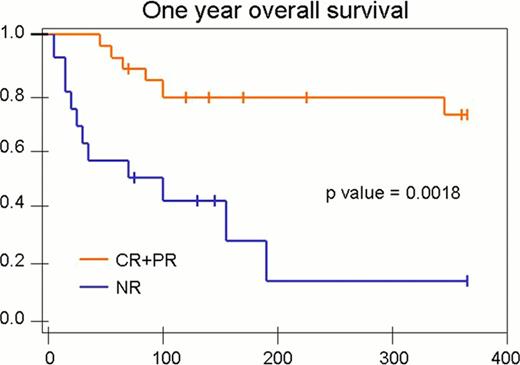Abstract
Abstract 743
Acute Graft versus host disease (aGvHD) is a severe complication of allogeneic hematopoietic stem cell transplantation (HSCT). Conventional treatment with high dose steroids fails to achieve a complete and sustained response in more than 50% of patients. Several second line treatments have been described but none of these can be considered superior or a standard of care (Paul J. Martin et al, BBMT 2012). Among these treatments, the use of third party mesenchymal stromal cells (MSC) has been proposed (LeBlanc et al, Lancet 2008). In this study, we assessed the safety and efficacy of third party human MSC, in a prospective, multicenter, phase I study (EudraCT 2008–007869-23).
Forty-seven patients with steroid-resistant, acute or chronic grade II-IV GvHD were enrolled into this study. Human MSC were obtained from bone marrow harvests of healthy donors and expanded in vitro using serum free medium supplemented with human platelet lysate (Capelli C et al, BMT, 2007; Capelli C. et al, Cytotherapy 2009). In vitro expanded MSC were produced in two officially authorized Cell Factories and tested in four Italian Hematology Units. The primary endpoint of this study was the safety. Secondary endpoints were the response of GvHD (evaluated 28 days after the last MSC infusion), as well as the overall survival and transplant-related deaths. Blood samples were periodically collected before and after MSC infusion to measure plasma levels of IL2Ralpha by ELISA, as previously described by our group (Dander E et al, Leukemia 2012).
Between August 2009, and June 2012, 47 patients (16 children, 31 adults, median age 25.5 years, range 1 to 67) were treated. The median dose of infused MSC was 1.5×106 cells per kg bodyweight. Enrolled patients presented with aGvHD in 37 cases, chronic overlap syndrome in 7 cases, and chronic classic GvHD in 3 cases. Fifteen pts had grade II GvHD, 23 grade III and 9 grade IV, according to NIH criteria. In 17 cases GvHD involved a single organ, in 24 cases 2, and in 6 cases 3 organs. Prior to MSC infusion 22 patients had received only high dose steroids, 12 patients received one cycle of pentostatin (1 mg/kg bodyweight for 3 days, Schmitt T. et al BMT, 2011: 46 580–585), while 13 received other conventional immunosuppressants. Patients received a median of 3 MSC infusions (range 1 to 8). No side effects were registered immediately after MSC infusion and no complications were lately referred as MSC-related. Overall, in 30 patients (63.8%) a clinical response of GvHD was registered. Thirteen of these patients (27.6%) had a complete response and 17 (36.1%) a partial response to treatment. Twenty-two of the 30 responding patients did not require further lines of immunosuppression after MSC infusion. Response was significantly more likely in patients exhibiting grade II GvHD versus those exhibiting more severe gradings (87.5% vs. 51.6%, p = 0.02) and in patients receiving MSC in a time interval of 30 days from the onset of GvHD (75.9% vs. 43.7%, p= 0.05). Current median follow up for this cohort is 200 days (range 30–1066). Responders show a significant lower transplant-related mortality (10.0% vs. 88.2%, p <0.05) and a better overall survival probability than non responders (23.3% vs. 88.2%, p <0.05, Fig. 1). Within the limit of a small subgroup analysis, adult patients receiving pentostatin before MSC had an apparent better response and survival (65% vs 27%, at 1 year), without an increased risk of infections.
Measurements of plasmatic levels of IL2Ralpha, when comparing responders vs non-responders patients, showed a statistically significant difference in terms of fold decrease of the marker (p=0.027), corroborating clinical results. Similarly, a significant trend of fold decrease change (p=0.058) was observed when comparing responding patients receiving MSC within or after 30 days from the onset of the disease, in line with clinical results.
This study confirms that human MSC prepared in academic cell therapy facilities may represent a safe and effective treatment of patients with steroid-refractory GvHD. Plasmatic inflammatory markers may help in evaluating and monitoring of clinical response. The sequential or combined administration of MSC and other immunosuppressants, such as pentostatin, is equally safe and feasible and deserves further investigation. We suggest to consider the use of MSC promptly, as early as possible, after steroid failure.
No relevant conflicts of interest to declare.
Author notes
Asterisk with author names denotes non-ASH members.


This feature is available to Subscribers Only
Sign In or Create an Account Close Modal